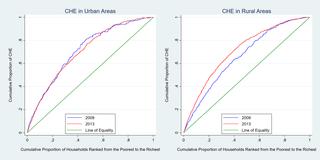PLOS ONE ( IF 3.7 ) Pub Date : 2018-03-16 , DOI: 10.1371/journal.pone.0194539 Yongjian Xu , Jie Ma , Na Wu , Xiaojing Fan , Tao Zhang , Zhongliang Zhou , Jianmin Gao , Jianping Ren , Gang Chen

|
Introduction
In 2009, China officially launched the New Health Care Reform (NHCR). One important purpose of the reform was to reduce financial burden of health care through health insurance expansion and health care provider regulations. This study aimed to provide evidence on the effect of the NHCR reform on catastrophic health expenditure (CHE) by comparing the occurrence and inequality of CHE among households with chronic diseases patients before and after the reform.
Methods
This study used the subset of data from the 2008 and 2013 National Health Services Survey conducted in Shaanxi Province. Our sample included households with chronic diseases patients and excluded observations with key variables missing. The final sample size was 1942 households in 2008 and 7704 households in 2013. We defined CHE occurrence following the definition of the World Health Organization (WHO). The income-related inequality in CHE was measured by the concentration index. A multi-level logistic regression model was used in the study to explore the influence of the NHCR on CHE occurrence, controlling for important covariates.
Results
From 2008 to 2013, the occurrence rate of CHE in rural areas declined from 29.15% to 23.62%. However, the CHE rate in urban areas increased from 19.18% to 24.95%. The interaction term between year and rural/urban location was statistically significant, confirming that the influence of the NHCR on the CHE occurrence rates were heterogeneous between rural and urban areas. As for the CHE inequality, the concentration index in rural areas decreased from -0.4572 to -0.5499 with a p-value less than 0.05. This implied that the CHE occurrence inequality was increased after the implementation of the NHCR.
Conclusion
Our study suggested that the implementation of the NHCR might not have been effective in reducing the CHE occurrence for households with chronic disease patients. Although the occurrence of CHE of rural households had decreased, the occurrence of CHE in urban areas was higher than before. In addition, the income inequality of CHE occurrence was greater in 2013 compared to that in 2008 in rural areas. Although the reform resulted in higher insurance coverage and higher government expenditure in health care, the financial burden of health care on households did not necessarily improve. Further efforts on developing the current health insurance system and optimizing the hierarchical health care system are required to improve the protection against CHE.

























 京公网安备 11010802027423号
京公网安备 11010802027423号